Decision by Army Engineers Boosts Chula Vista’s Plans for Bayfront
- Share via
CHULA VISTA — Chula Vista’s long-delayed plans to develop its empty bayfront received a boost Friday when the Army Corps of Engineers decided it has no say in whether the city will build a road through the Sweetwater Marsh complex to Gunpowder Point.
The corps announced that the city no longer needs a federal permit from the agency, now that the city intends to build the road on pilings above the environmentally sensitive marsh rather than on a levee running directly through it.
“This is the first major step for us to start construction and get the area opened to the public,” said Chula Vista Councilman David Malcolm, who has pushed hard for the $500-million bayfront development first proposed about 14 years ago.
“The problem that we had with the corps reviewing (the road) was that the Sierra Club could appeal its decision to the next branch,” Malcolm said. “The EPA could have appealed it--and said they would. So we would be caught up in the bureaucratic mess of years of trying to get the permit.”
Malcolm said the city still must secure a few remaining state approvals before it can begin building the approximately 200-foot-long road. Nevertheless, he said he hopes construction might begin in as little as 30 days.
The road will traverse the marsh to Gunpowder Point, where the city intends to build a nature center and a hotel. Controversy over the road escalated last spring when the U.S. Fish and Wildlife Service concluded it would jeopardize the survival of three endangered species.
At the time, sources said that the Army Corps was on the verge of denying the permit that the city needed to build the road. But at the last minute, the corps withheld its decision and agreed to give Chula Vista more time to submit an acceptable proposal.
In July, the city proposed “a radical departure” from the six other proposals already ruled unacceptable, a spokeswoman for the Army Corps in Los Angeles said Friday. The plan calls for a two-lane road on an elevated bridge built on pilings driven into the marsh.
The Army Corps has no jurisdiction over such a scheme, spokeswoman Susan Kranzler said Friday. Because the agency regulates only dredging and filling in waterways, and the new plan involves neither, the city no longer needs a permit from the corps.
“They did not design it this way to avoid our jurisdiction,” said Glenn Lukos, chief of the south coast section of the regulatory branch of the Army Corps. “They did it because Fish and Wildlife required it of them, to avoid impacts on endangered species. But we realized that they had designed themselves right out of a permit.”
According to a statement released by the agency, the pilings will be driven into place and the fill for the approaches will be placed outside wetland areas. “No fill or dredged material would be placed . . . in any wetlands for any reason,” the release said.
Lukos said Friday that the Fish and Wildlife Service concluded July 28 that the new plan will have “no direct adverse impacts on endangered species.” Representatives of the wildlife service could not be reached for comment late Friday.
More to Read
Sign up for Essential California
The most important California stories and recommendations in your inbox every morning.
You may occasionally receive promotional content from the Los Angeles Times.













